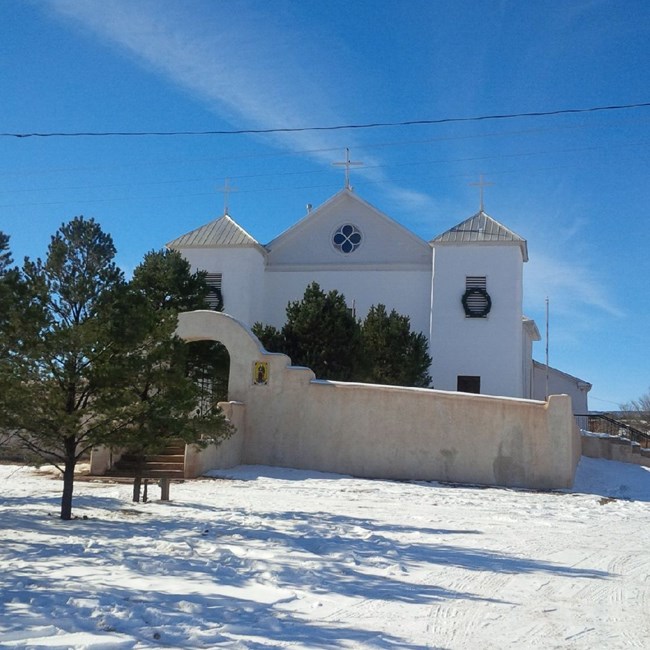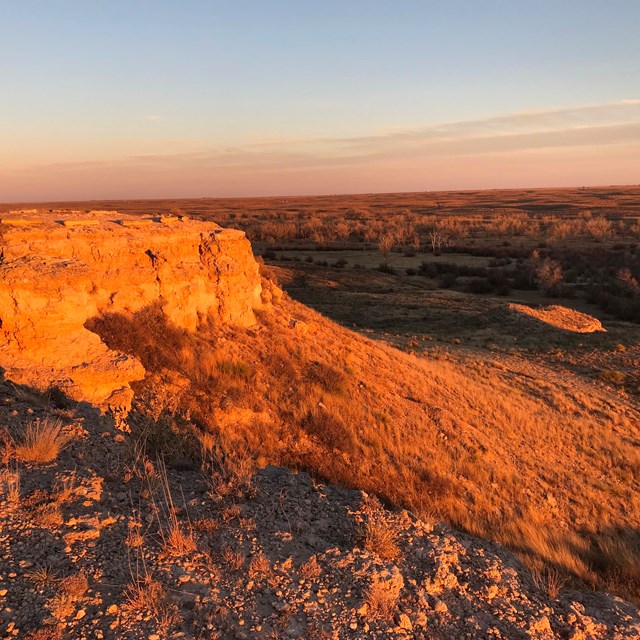Part of a series of articles titled University of New Mexico Student Essays: Santa Fe National Historic Trail.
Article
University of New Mexico Student Essay: San Miguel del Vado Historic District

Photo/NPS/Sánchez-Clark
San Miguel del Vado Historic District
By Zoe Wiesel
San Miguel del Vado ('Saint Michael of the Ford') was an important crossing of the Pecos River along the Santa Fe Trail. Located east of Santa Fe, the village served as the seat of San Miguel County until 1860 when the title was transferred to the rapidly growing community of Las Vegas, New Mexico.
Spanish Settlement
In 1794, the Spanish governor of Santa Fe de Nuevo México granted a large swath of land in the upper Pecos River Valley to more than fifty different petitioners, each representing a different family. San Miguel del Vado was the first community founded on this land grant, counting Hispanic settlers, Indians from Pecos Pueblo, converted Comanche, and enslaved American Indians (also called genízaros) among its residents (or vecinos). Like many other frontier settlements, San Miguel del Vado served to protect the colony's interior from Comanche raids.
Many of the village's residents raised stock or grew crops using acequîas (irrigation ditches) that carried water from the Pecos River. Like nearby Pecos, San Miguel del Vado served as a gateway to the plains; buffalo hunters called ciboleros often used the village as a jumping-off point for their expeditions. As San Miguel del Vado's population increased, the village received a church in the early 1800s. The village continued to grow and, by 1812, there were 230 heads of family in the area. Many believed that San Miguel del Vado would become one of the biggest towns in the province. The 1827 census confirmed this assumption, showing that the village had almost 3,000 inhabitants.
A Gateway to Santa Fe
Located at an easy crossing of the Pecos River, San Miguel del Vado also lay at the edge of an empire. During the Spanish period, the village served as a buffer against Comanche raids but also against American and French merchants trying to (illegally) reach Santa Fe. Once Mexico gained its independence in 1821, though, it welcomed trade with the United States. This about-face meant that San Miguel del Vado was now the official eastern entrance into New Mexico, and the first settlement encountered by westward travelers after their long journey across the plains.
San Miguel del Vado and the Santa Fe Trade
Merchants would stop here and repackage or combine their goods to reduce their loads, thus avoiding duties and other extra fees once they reached Santa Fe. Some French and American merchants would conduct their business in one of San Miguel del Vado’s plazas, bypassing Santa Fe completely on their way to Chihuahua—and thereby avoiding taxes altogether. The Mexican government eventually stationed troops in San Miguel to stop smuggling and tax evasion by merchants on the Santa Fe Trail.
Historic Plaza
San Miguel has many historic buildings from different architectural periods. The center of town is bisected by the Santa Fe Trail and the Pecos River, essentially creating two distinct plazas. The two oldest buildings on the east side of the plaza, the Dance Hall and Zaguan House, retain Spanish period characteristics including low windows and wood ceilings. West of the Plaza lies the foundation of the old San Miguel County courthouse and what may have been a hotel, remnants of the town's more recent history.
San Miguel del Vado Church
San Miguel del Vado's church is located on the west side of the plaza. The church is one of the oldest remaining buildings in the settlement, but its mixed styling--featuring Gothic windows and spires, wood and linoleum floors, and a bell added in 1821--speak to multiple layers of the town's history. Despite these different design influences, the internal structure of the church is the same as when it was built in 1805, and it still functions as the cultural center of the village. Southwest of the historic church, metal and ceramic artifacts still litter the ground. These were likely left by Santa Fe Trail travelers that stopped to rest or trade in San Miguel del Vado.
San Miguel del Vado on the International Stage
In 1841, a Texan expedition to New Mexico ended up lost and hungry near the Pecos, where Mexican troops apprehended them. Since the outfit was part of a Texan campaign to annex the northern Rio Grande region, the Mexican government held them captive in San Miguel del Vado before marching them south to meet their fate. The Texans’ journals say the women of San Miguel and the parish priest treated them with much kindness.
As the eastern gateway to New Mexico, San Miguel del Vado also played a role in the Mexican-American War. General Stephen W. Kearny used the Santa Fe Trail during the seizure of Santa Fe in August 1846. Before reaching Santa Fe, however, Kearny took control of San Miguel del Vado. The Mexican-American War ended in 1846 with the signing of the Treaty of Guadalupe Hidalgo and what we now know as New Mexico became a part of the United States.
Decline in the Second Half of the Nineteenth Century
As an agricultural economy dependent upon stock (mainly cattle), San Miguel del Vado struggled to keep pace with the region’s industrialization. The economic and political center of San Miguel County shifted to Las Vegas in 1860. With construction of the Atchison, Topeka & Santa Fe Railroad, San Miguel began to see its young men and workers leaving for better economic opportunities in Las Vegas, Santa Fe, or southern Colorado. This downward trend continued into the second half of the nineteenth century as the Supreme Court ruling of 1897 shrunk the San Miguel del Vado grant from 300,000 acres to 5,000 acres. This decision cut the village off from its abundant rangeland, farmland, and timber.
San Miguel del Vado Today
San Miguel del Vado is located roughly 45 miles from Santa Fe along NM State Route 3, which follows the original route of the Santa Fe Trail. The village was bypassed by construction of the interstate highways in the twentieth century. Because San Miguel del Vado is off the beaten path, it was able to maintain its identity as a prime example of a Spanish colonial and early Mexican settlement. This district has been preserved as an integral part of the Santa Fe Trail's history.
---
Beauvais, Robert J. "San Miguel del Vado Historic District." National Register of Historic Places Inventory/Nomination Form. Santa Fe: New Mexico State Planning Office, 1972.
Jenks, Kelly. "Archeology at San Miguel Del Vado." New Mexico State University Department of Archeology. https://anthropology.nmsu.edu/anthropology-faculty/jenks/san-miguel-del-vado/.
__________. "Vecinos en la Frontera: Colonial History and Archaeology at San Miguel del Vado, New Mexico." SMRC Revista (Spring/Winter 2011): 15–25.
Weiser-Alexander, Kathy. “San Miguel del Vado.” Legends of America. https://www.legendsofamerica.com/san-miguel-del-vado/.
Note: This collaborative research project was formulated to give students of all levels in the University of New Mexico’s Department of History valuable academic and professional experience while also providing trail partners (and the general public) with useful essays on historic trail sites. This particular essay comes from a student in Dr. Fred Gibbs’ class on the national historic trails in fall 2018. Learn more on the collaboration that made this course possible.

Photo/NPS/Sánchez-Clark
A Personal Story
Luis G. Sánchez's (pictured) great grandfather--and Victoria Sánchez's (pictured) great-great-great grandfather!-- Julian Aragon y Perea, was born in Belen, New Mexico, in 1830 and grew up in Bernalillo, New Mexico. At the age of 17 he moved with his family to the area of San Miguel del Vado, where in October 1848 he joined an ox train heading from Santa Fe to "the United States," traveling on the Santa Fe Trail.
After two months of travel, they arrived in Independence, Missouri. He worked and lived there for three years and even attended public school. During his time in Missouri, he drove an ox cart, worked as a tailor, and finally as a wagoner on a train of 25 carts headed back to Santa Fe. He used the money he earned to help his family and to set himself up in business before marrying and starting a family in Anton Chico.
Last updated: January 26, 2021


